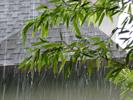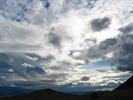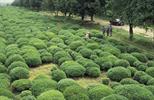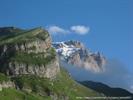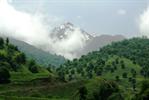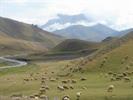The best time to visit lowland Azerbaijan is April to June, when skies are clear and the land is green and full of flowers.
With so many mountain chains and a large sea border, Azerbaijan has more different climate areas than any other country its size. Scientists divide the world into 13 different climate zones, and Azerbaijan has nine of these, ranging from humid subtropical to desert to alpine. Temperatures and rainfall vary dramatically across the country. Rainfall is eight to 12 inches in the coastal region and in the southeastern lowlands, 12 to 35 inches in the foothills of the medium-elevation mounts, 39 to 51 inches on the southern slopes of the Greater Caucasus, and 47 to 55 inches in the southern lowland. In the lowland, precipitation falls in the winter, while in the mountains and foothills it falls in the summer. The result is an amazing variety of plants and wildlife, as well as diverse land for raising crops and animals. The country has more than 4,000 species of plants and more than 12,000 species of animals native to its lands. It also has several hundred types of birds, as well as both freshwater and saltwater fish.
Autumn arrives suddenly in mid-September often bringing with it low clouds and drizzle that can obscure the views for two or three weeks. October is also lovely in Baku, with warm days and crisp nights, though much of the countryside is parched brown.
Summer is unpleasantly hot in low-lying areas (35-40 degree by Celcium), with Baku unpleasantly humid (34-37 degree by Celcium). Baku is famous for its winds which bluster a few times a month mitigating the unpleasantly humid, summer heat, disrupting Caspian shipping or adding a bite to the mild chill of winter. However, in the higher mountains July is the ideal trekking season, although you might still need a decent jacket at night, and good winter woollens if you stay overnight in Xinaliq, even in July. In August people try to escape unbearably sweaty Baku for the cool hills of Pirguli or Alti Agach, or flock to the local beaches of the Absheron peninsula.
Winters are mild around the Caspian shores but can get strikingly cold inland. Nonetheless, only the more remote mountain villages get snowed in winter. You will need heavy sweaters in Sheki and the mercury can dip below -20 C in Xinalyq or Lahich, with snow ploughs struggling to keep the roads open.
The flat centre of the country is typically dry with the irrigated farmland veering on semi desert. In contrast the southern forests are wet with the heaviest rains in October, November and March. The area is best for hiking in May. May is also ideal for visiting the west with fields full of flowers and a good chance of clear skies. Only in July does the snow clear sufficiently to allow trekking across the high passes around Xinaliq.
The southeastern Talysh region has a humid subtropical climate. It receives more than 50 inches of rain a year. Summer temperatures often reach more than 90 degrees Fahrenheit. Although most of the rain falls in the winter, enough falls in the summer to keep the area extremely humid. As a result, this area of the country is covered with subtropical forests. The Nagorno-Karabakh region, occupied by Armenians, lies in the southwest. It is blanketed with lush mountain woodlands. The mountains do not get extremely high, so the area does not receive the devastating snowfalls and cold that high mountain peaks receive. Mountain goats, deer, and lynx make their homes among the broadleaved forests.
Important information on visa: If you're going to vizit Azerbaijan check the latest information of visa regime here >>>. Regularly updated data, helpful advice and expert guidance from licensed travel agency. If you have any questions, please do not hesitate to contact us.



